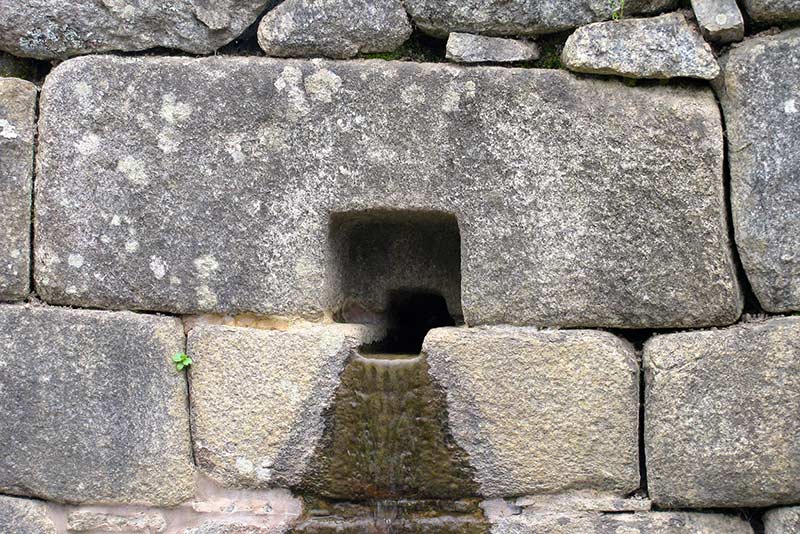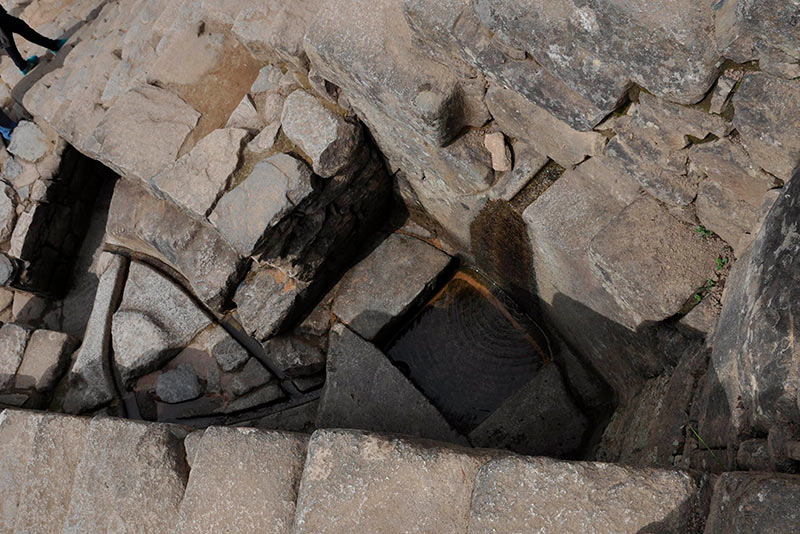Machu Picchu, example of hydraulic engineering
Machu Picchu is considered an example of hydraulic engineering. The Inca city is located in the heart of the Cusco rainforest, a place with heavy and constant rainfall. In order to build a stone city, the Incas had to drain all this accumulated water. That’s when they built water fountains and channels with such perfection that they still amaze researchers today. Discover how to visit the famous water fountains of Machu Picchu!
- Machu Picchu, an example of hydraulic engineering
- The water fountains of Machu Picchu
- Where are they? How to get there?
- History of the water fountains of Machu Picchu
- How to visit the water fountains of Machu Picchu?
- What are the visiting hours?
- More information about your visit to the water fountains
- Questions and answers about the water fountains of Machu Picchu
Machu Picchu was built on a geological fault with a quarry ideal for Inca construction. However, due to its location in the high jungle of Cusco, the Incas faced a difficult challenge: how to evacuate the large amount of rainfall? That’s why they built a vast network of channels and water fountains. These still drain the area’s water to this day. Thanks to that, Machu Picchu is a construction that endures over time. Discover it!
Machu Picchu, an example of hydraulic engineering
- The Incas achieved a high level of development in hydraulic technology.
- As an example of their skill in water management, they built important ceremonial centers dedicated to the worship of water such as: Tipón, Inkilltambo, Ollantaytambo, and even Machu Picchu.
- In the Inca citadel, there are dozens of ceremonial water fountains, considered elements of purification according to the Inca worldview.
- Perhaps the most famous ceremonial construction for water worship in Machu Picchu is ‘The liturgical fountains’, also known as the ‘Stairway of the fountains’ of Machu Picchu.
- However, in Machu Picchu there are dozens of fountains and water channels that served the purpose of draining accumulated water, especially during the rainy season (in January alone, it rains approximately 2,300 millimeters).
- Additionally, water flowed through important enclosures such as the Temple of the Sun or the House of the Inca.
- For all these reasons, Machu Picchu is considered an example of hydraulic engineering.
The water fountains of Machu Picchu
- Machu Picchu has dozens of water fountains that served to channel the water accumulating in the citadel, as well as to supply clean water to its inhabitants.
- The fountains also had a liturgical function, worshipping water. These places represented purification.
- The water fountains of Machu Picchu are made of granite stone, which is abundant in the area. After more than 500 years, water continues to flow non-stop in Machu Picchu.
- In 2009, four ceremonial fountains were even discovered in the eastern terrace sector of the Inca citadel.
- There is a main channel that covers approximately 700 meters from the water source to the urban area.
Where are they? How to get there?
- The water fountains of Machu Picchu are located in both the urban and agricultural areas of the archaeological site.
- To get there, you need to purchase a ticket that includes Circuit 2 (classic route) or Circuit 3 (royal route) of Machu Picchu.
- Circuit 2 covers the middle sector of the Inca citadel, including some agricultural and urban areas.
- Circuit 3 passes through the lower part of Machu Picchu, covering the entire urban sector.
When purchasing your ticket to Machu Picchu, you will notice that there are 10 types of entries available, although during certain times of the year they are reduced to only 6.
- High season tickets – June 19 to November 2
- Machu Picchu Mountain Route (1A)
- Upper Terrace or Classic Photo Route (1B)
- Inti Punku Gate Route (1C)
- Inca Bridge Route (1D)
- Designed Classic Route (2A)
- Lower Terrace Classic Route (2B)
- Huayna Picchu Mountain Route (3A)
- Designed Royal Route or Lower Temples (3B)
- Great Cavern or Temple of the Moon Route (3C)
- Huchuy Picchu Mountain Route (3D)
- Regular season tickets – November 3 to June 18
- Machu Picchu Mountain Route (1A)
- Upper Terrace or Classic Photo Route (1B)
- Designed Classic Route (2A)
- Lower Terrace Classic Route (2B)
- Huayna Picchu Mountain Route (3A)
- Designed Royal Route or Lower Temples (3B)
History of the Water Fountains of Machu Picchu
- Like the rest of Machu Picchu’s constructions, the water fountains were built by order of Emperor Pachacutec around 1450.
- In the water fountains, the Incas held purification ceremonies. Additionally, they served to drain water in a place where it can rain heavily throughout the year.
- Despite the abandonment of the city (in the 16th century) and the accumulation of vegetation at the archaeological site, the fountains continue to channel water in Machu Picchu.
- The fountains have a very practical function: to supply clean water to the inhabitants, ensuring its distribution and supply.
- Today, the water fountains are one of the most famous constructions in Machu Picchu.
How to visit the water fountains of Machu Picchu?
- The water fountains can be visited with most tickets to Machu Picchu, including those that cover the classic circuit or the royal circuit.
| Tickets that include the Water Fountains | |||||
|---|---|---|---|---|---|
| Ticket | Attraction | Tour Circuit | Availability | Advance Booking | Restrictions |
| Classic Machu Picchu Designed (route 2A) | Covers the agricultural and urban sectors of Machu Picchu | Circuit 2 – Classic Route | All year round | 3 months in advance | Suitable for all ages |
| Classic Machu Picchu Lower Terrace (route 2B) | Covers the agricultural and urban sectors of Machu Picchu | Circuit 2 – Classic Route | All year round | 3 months in advance | Suitable for all ages |
| Machu Picchu + Huayna Picchu (route 3A) | Covers the lower urban sector of Machu Picchu plus the hike to Huayna Picchu | Circuit 3 – Royal Route | All year round | 2 months in advance | Only for ages 12 and above |
| Designed Royal Machu Picchu or Lower Temples (route 3B) | Covers the lower urban sector of Machu Picchu | Circuit 3 – Royal Route | All year round | 2 months in advance | Suitable for all ages |
| Machu Picchu + Great Cavern or Temple of the Moon (route 3C) | Covers the lower urban sector of Machu Picchu plus the hike to the Great Cavern | Circuit 3 – Royal Route | High season only (June 19 – November 2) | 1 month in advance | Only for ages 12 and above |
| Machu Picchu + Huchuy Picchu (route 3D) | Covers the lower urban sector of Machu Picchu plus the hike to Huchuy Picchu | Circuit 3 – Royal Route | High season only (June 19 – November 2) | 2 months in advance | Only for ages 12 and above |
What are the visiting hours?
- The water fountains of Machu Picchu are open to tourists every day of the year, from 6:00 a.m. to 5:00 p.m.
- Each ticket has its own entry time, varying according to the 10 available entry slots, the first at 6:00 a.m. and the last at 3:00 p.m.
More information about your visit to the water fountains
- The House of the Inka (located below the Temple of the Sun) has water channels and its own fountain. This area was intended for the Inca emperor or his royal family during their visits to Machu Picchu.
- In 2009, research work at Machu Picchu discovered four ceremonial fountains located in the eastern terrace sector of the Inca citadel.
- During the rainy season (November to March), you’ll see the fountains flowing with more water, while during the dry season (April to October), the water flow is lighter.
- You can only enter Machu Picchu with one of the 6 tickets that include circuit 2 (classic route) or circuit 3 (royal route).
- During the high season (June 19 to November 2), all tickets to the water fountains are available.
- In contrast, during the regular season (November 3 to June 18), only four are available: Designed Classic Route (2A), Classic Lower Terrace Route (2B), Huayna Picchu Mountain Route (3A), and Designed Royal Route or Lower Temples (3B).
- Book your tickets for the classic circuit of Machu Picchu 3 months in advance, while for the royal circuit, 2 months in advance is enough.
- Acclimatizing is essential before visiting the Inca citadel. Spend your first days in Cusco doing light activities to avoid altitude sickness.
- Remember, you can plan your dream trip with Boletomachupicchu, where you’ll find a wide variety of tourist packages and tours that will make you live an unforgettable experience in Machu Picchu.
Questions and answers about the water fountains of Machu Picchu
1. What are the water fountains of Machu Picchu?
Machu Picchu has dozens of fountains and water channels to drain the high amount of rainwater. The Incas also performed purification ceremonies at these fountains.
2. Where are they located?
The water fountains are located in both the agricultural and urban sectors of Machu Picchu. For example, in 2009 four ceremonial fountains were discovered in the eastern terrace sector.
3. How to reach the water fountains of Machu Picchu?
To visit the water fountains, you need to enter Machu Picchu and ascend to the Guardian’s House sector. From there, you continue walking toward the urban sector. The fountains are best seen from the lower part of the citadel, at the House of the Inka and the terrace area.
4. Which ticket allows me to visit the water fountains of Machu Picchu?
Only 6 of the 10 Machu Picchu tickets allow access to the water fountains: Designed Classic Route (2A), Classic Lower Terrace Route (2B), Machu Picchu + Huayna Picchu (3A), and Designed Royal Route or Lower Temples (3B).
5. Who ordered the construction of the water fountains in Machu Picchu?
According to chronicles, Emperor Pachacutec ordered the construction of the water fountains along with the rest of Machu Picchu’s buildings in the mid-15th century.
6. What are the visiting hours of the water fountains of Machu Picchu?
You can visit the water fountains of Machu Picchu every day of the year from 6:00 a.m. to 5:00 p.m.
7. What are the water fountains of Machu Picchu made of?
The water fountains of Machu Picchu are made of granite stone, which is abundant in the area (Machu Picchu is located on a geological fault).
8. When is a good time to visit Machu Picchu and its structures?
Any day of the year is a good time to visit Machu Picchu. Most tourists prefer the dry season (April to October) as the lack of rain makes outdoor tours easier.
9. Why are the water fountains of Machu Picchu important?
The water fountains in Machu Picchu are important because the Inca citadel is located in a rainy region. Without them, the site would collapse. Moreover, for the Incas, water was a spiritual purification element.
10. What other Inca water fountains can I visit in Cusco?
In Cusco, there are temples dedicated to water worship, including Tambomachay, Tipón, and Inkilltambo. Be sure to visit them!
Advice from people who have been there
 By: Waldo B.
By: Waldo B.“The best trip“
“How did I not come earlier? A true source of pride for us Peruvians. No wonder people come from so far away. And we, living so close, often don’t know it. Recommended for everyone.“
By Ticket Machu Picchu – Last updated, September 25, 2025

